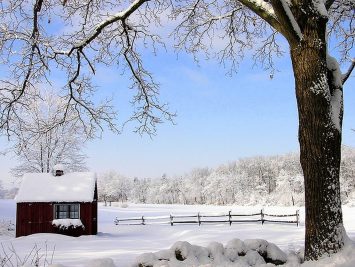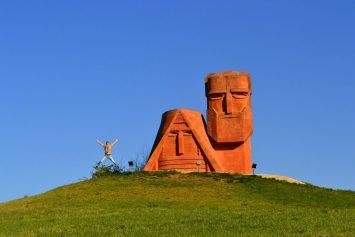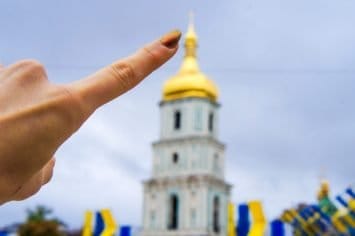Berlin is the perfect location for a city-break. The city simply has everything a modern traveler would want from a European capital.
Young travelers will enjoy the vibrant nightlife scene, with dance offerings available every day of the week.
Foodies will love the diverse range of affordable eateries that represent every cuisine in the world.
Art lovers will enjoy the radical contemporary art scene found in the city’s small galleries.

The last time I was in Berlin was in December. On the way from Singapore to my hometown Gdansk, Poland, I was visiting my friend Simon.
Because I like the city so much, and because it should be a part of your German travel itinerary, I just want to give you 5 tips for a short city trip to Berlin.
Quick Navigation
ToggleWhy You Should Visit Berlin
Berlin is incredibly interesting to me because it’s very contemporary and deeply historical. Modern Berliners go to work beside Checkpoint Charlie and take cocktails next to the former Berlin wall.
Berlin is welcoming to all travelers who want to discover the city’s unique history and experience modern life here now. Expect Berliners to chat with you in bars about where you have come from and why you’re here.
A lively music scene makes Berlin the perfect place for nightlife, but its history marks the city as incredible.
Some of the most turbulent episodes of 20th-century history happened in Berlin, to Berliners. Discovering this history will guarantee a fascinating and moving vacation.
What are 5 Things that You Have to Do in Berlin?
Berlin is Germany’s capital of government and its cultural capital, with a vibrant contemporary art and music scene. Modern Berlin is an exciting and invigorating place for laid-back travelers, but history lovers will absolutely adore it. So much of 20th-century history had the Berlin of the heart of it, and there are many unique sights which take travelers to the heart of it.
#1 Reichstag Building
Germany’s Reichstag building has had a dramatic history and has bore witness to one political upheaval after another. The Reichstag was first built in 1894 and hosted the government of the Weimar Republic until 1933 — but this fledgling democracy was not to last. Hitler’s Nazi Party set fire to the Reichstag in 1933 to seize control of the German government, and it was left badly damaged, and unoccupied. Following the Second World War, when Germany was divided, the Reichstag sat unoccupied in the military zone between East and West Berlin, despite some attempts to make it the seat of the West German government in the 1960s. The Reichstag remained unused until the 1990s when it became the seat of the government of reunified Germany. Now, the building is symbolic of modern Germany’s democratic values. Visit to learn all about Germany’s dramatic history.

#2 The Berlin Wall Memorial
The Berlin Wall Memorial is a must-see for any travelers interested in the dramatic and traumatic history of post-war Berlin. The Memorial is a preserved section of the real wall which once divided the communist East and the capitalist West Berlin. Families who had once lived on different sides of Berlin before the war, soon found themselves living in different states. After the wall was torn down in 1991, Berliners decided to keep some sections of the wall in place as a reminder of their divided history.

Not only is the Berlin Wall Memorial a great place to learn about the history of Berlin, but it also has some fantastic street art too. Most travelers will recognize ‘The Kiss’ which shows the East German and Soviet leader in a disquieting embrace.
#3 The Holocaust Memorial
The Memorial of the Murdered Jews of Europe, colloquially known as the Holocaust Memorial, is one of the world’s most deeply moving memorials of remembrance. The Memorial is made of nearly 3,000 slabs of fluctuating heights which look like graves. They are similar in color and shape to the mass graves, marked with rough stones, of Holocaust death camp Treblinka. There is no central section of the Memorial, but the slabs encourage visitors to take the time to walk across the site and reflect on the horrors of the Holocaust. The city of Berlin has not tried to bury and forget its Nazi past. Instead, this monument aims to afford the Jewish victims of Nazism the respect they deserve.

#4 Checkpoint Charlie
Checkpoint Charlie was once the border crossing checkpoint for anyone traveling between East and West Berlin. The border checkpoint was named Checkpoint Charlie because that’s the 3rd letter in the phonetic alphabet and this was the third allied checkpoint. The name stuck because of the American soldiers who manned it. During the Second World War, the allies maintained this checkpoint, and the Americans stayed on after the war was over. During a period of escalating tensions, American and Soviet soldiers had a brief confrontation here in 1961 but it didn’t amount to genuine conflict. Over the course of Soviet-era, many East Berliners defected to the West from this checkpoint. The checkpoint was demilitarised in June 1990. Today, travelers can go to pose with the ‘You Are Now Entering the American Sector’ sign and with the actors dressed as soldiers who man it today.
#5 Brandenburg Gate
The Brandenburg Gate is Germany’s most iconic piece of architecture and is famed world-over for its monumental, neo-classical style. The gate was constructed in 1791, in the style of Athens’ Acropolis. Above the gate is the world-famous ‘Quadriga’ statue, which shows the Goddess of Victory pulled on a statue by four-winged horses. Frederick William II, the King who commissioned it, intended it to be called the ‘Gate of Peace’, but the name was forgotten by history. Today, the Brandenburg Gate has come to be a symbol of a democratic and unified German republic, where once it marked the division between East and West Berlin.

When the Brandenburg gate was first opened in 1989, so many visitors from both sides of Berlin visited, the monument was severely damaged. After a refurbishment in the early 2000s, the Brandenburg Gate is better equipped to receive visitors than ever and is one of Germany’s top tourist attractions.

Berlin isn’t short of beautiful architecture and stunning monuments for the curious traveler to discover. The major sites of Berlin are spread throughout this bustling capital city, so travelers can use bicycles to explore Berlin, or a ticket-buying service to help them get from one side to the other.
Whatever you like to do with your down-time, whether to explore history, eat great food or admire a beautiful building, there’s an experience for everyone in Berlin.
What is your favorite thing to do in Berlin?
Pin It For Later



